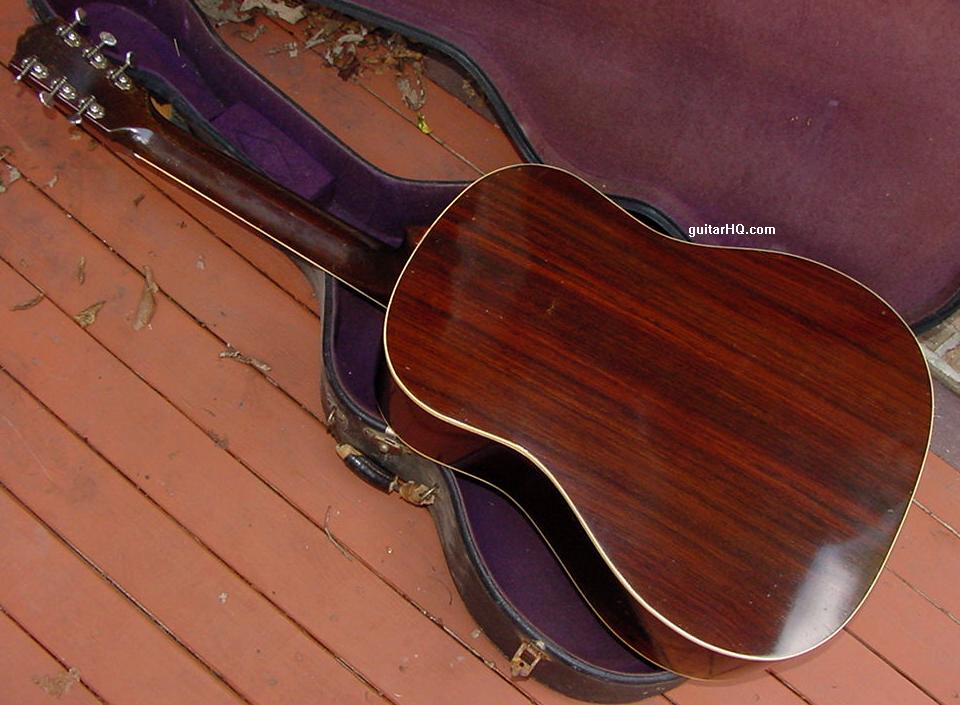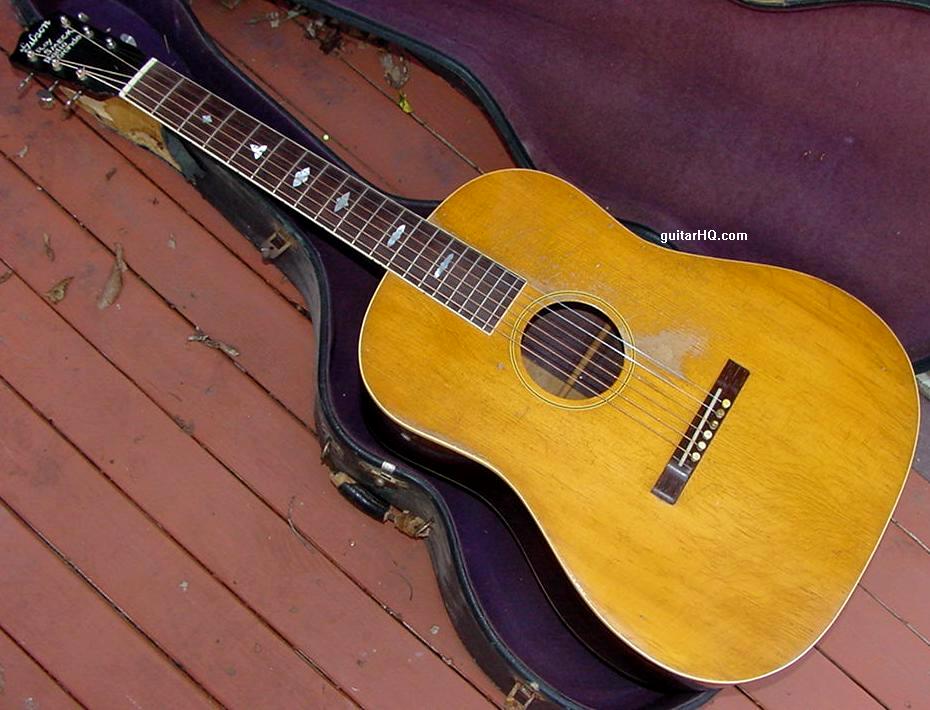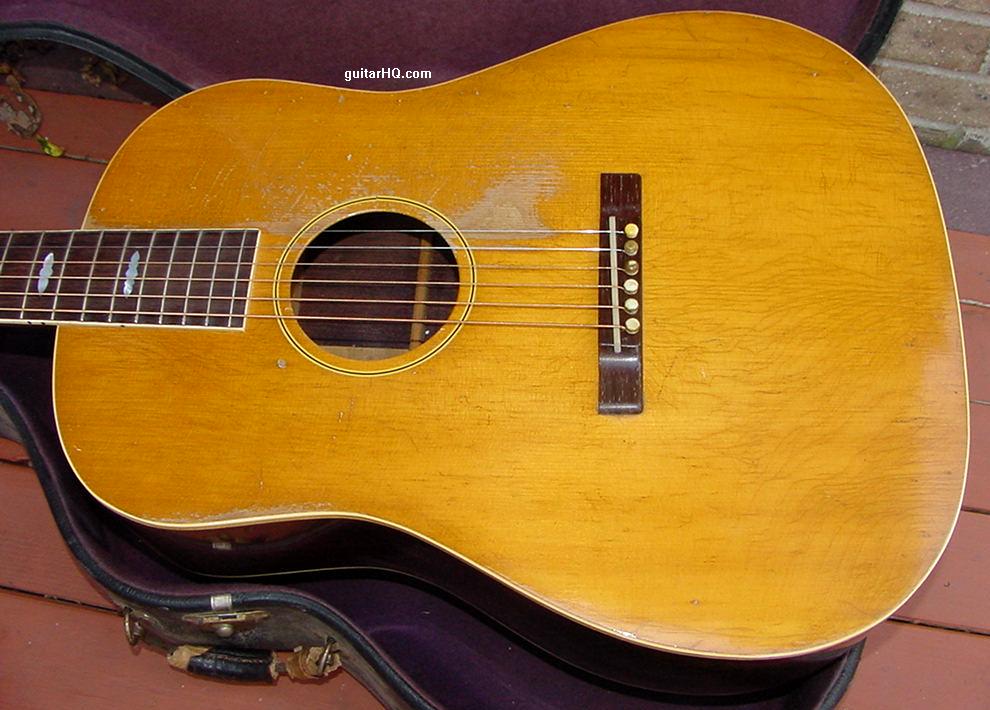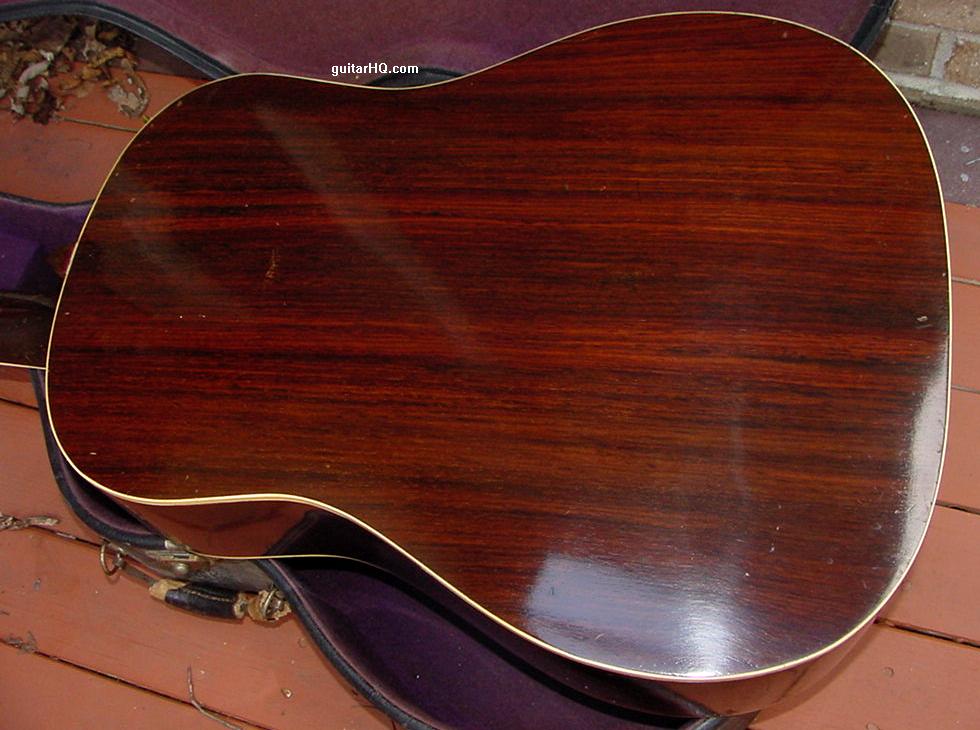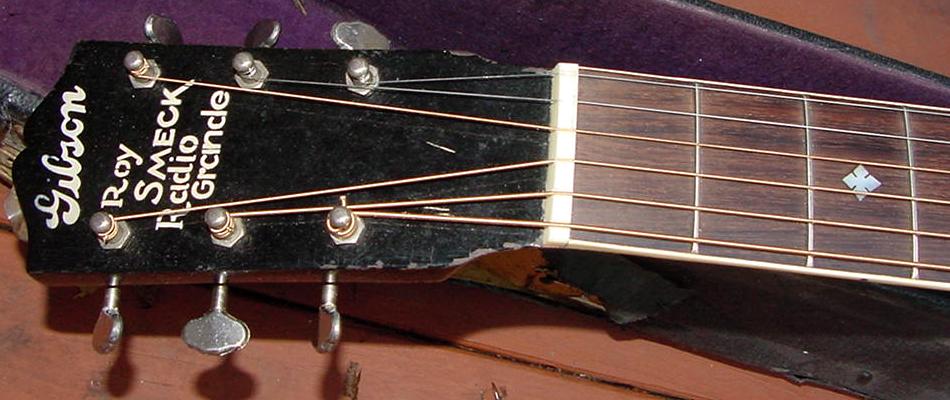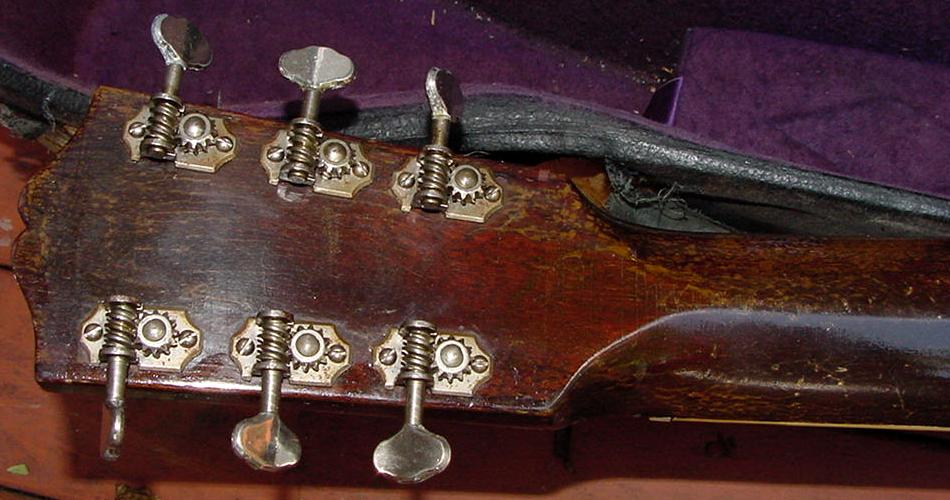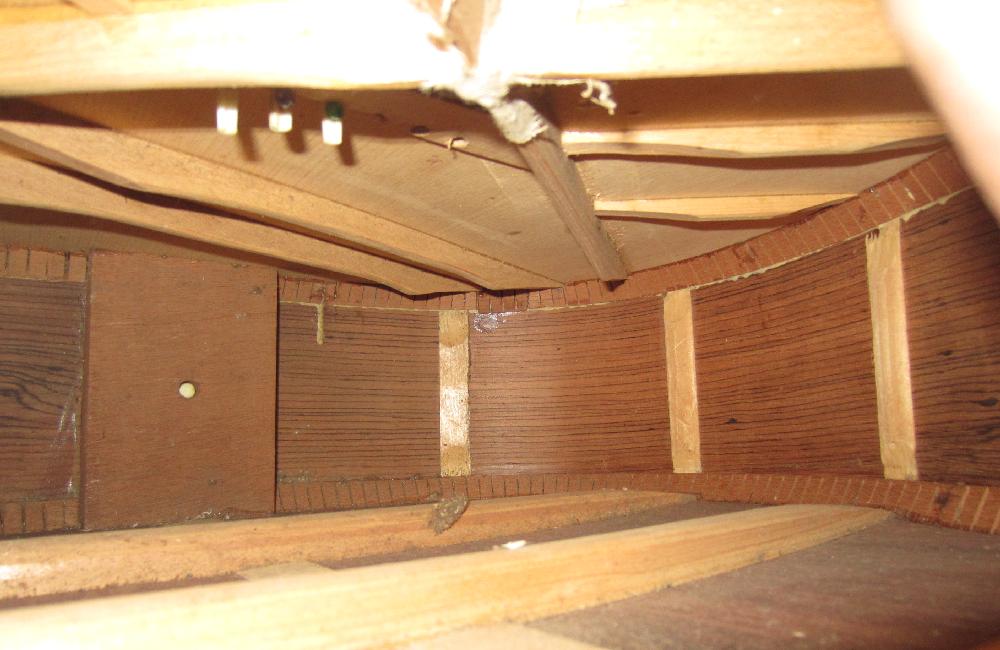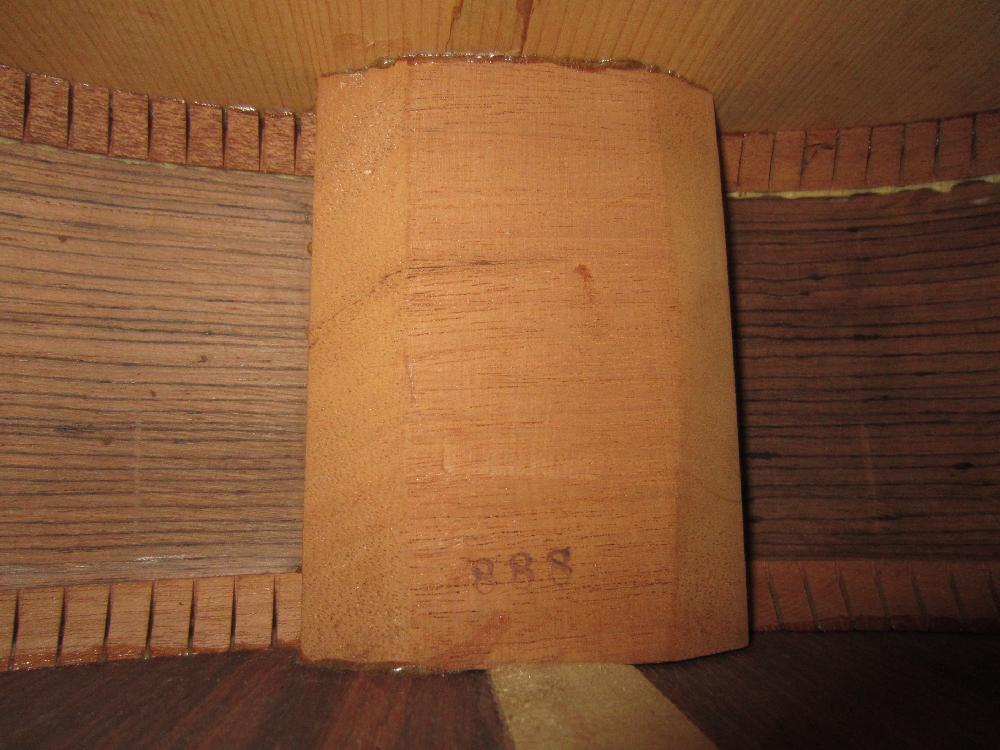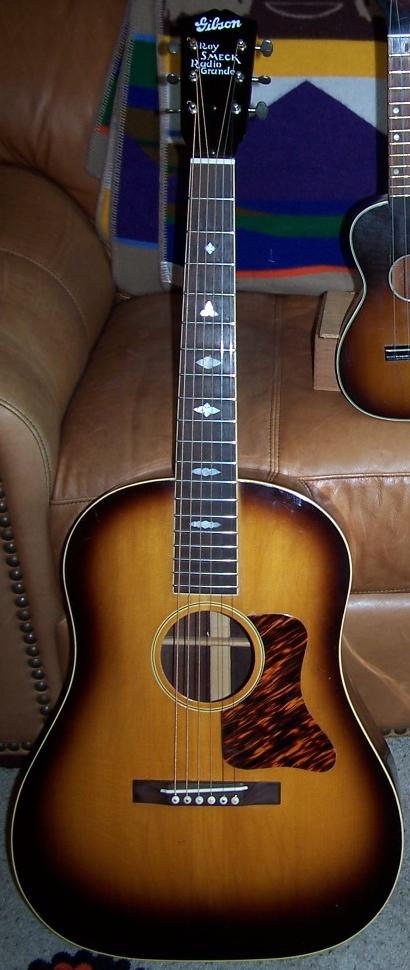Gibson Roy Smeck Guitars:
Gibson Roy Smeck Stage Deluxe
Gibson Roy Smeck Radio Grande
Description: Gibson Roy Smeck guitars
Available:
Stage Deluxe: 1934 to 1942.
Radio Grande: 1934 to 1939.
Collectibility Rating:
Stage Deluxe: C- (in original hawaiian set up).
Radio Grande: B- (in original hawaiian set up).
Gibson Roy Smeck guitars General Comments:
A great "X" braced, jumbo sized, 12 fret flattop from the 1930's.
They sound absolutely amazing. Unfortunately,
they are set up from the factory to be played hawaiian style. To make
this a viable spanish style guitar, the following must be done: neck reset
for proper angle, neck narrowed (and hence refinished)
to a standard size (original neck is HUGE at 2.25" wide,
and can't really be played spanish), frets added (stock there are just white
lines, but no frets!), bridge saddle angled for proper intonation.
Obviously this ruins much of the originality of the guitar, and costs
around $800 (or more!) to have it done properly. A collector/players nightmare.
Do you have it converted to make it playable, yet unoriginal? Or do you
leave it alone to keep it original, but essentially unplayable?
A "catch22" for sure since it's such a nice guitar.
A little about Roy Smeck himself.
He was a virtuoso on the banjo, Spanish guitar, Hawaiian
guitar, and ukulele. AKA "The Wizard of the Strings." He was one of
the great American popular musicians of the 20th century,
whose name would perhaps be much more recognizable if he hadn't
specialized in the ukulele (it was his favorite instrument).
He made over 500 recordings,
starting in 1921 and continuing until his last album in the mid-1960s.
Most of his studio recordings in the 1950s and 1960s were on the Hawaiian acoustic
guitar and steel guitar (though the ukulele remained his favorite).
He was a frequent guest on the many TV variety shows during the
1950s/1960s like Ed Sullivan, Steve Allen and Jack Paar. When Gibson released its
Roy Smeck Hawaiian acoustic guitar, it was only the second artist
model made. One of the very first Vitaphone movies was of
Roy Smeck playing guitar (Vitaphone was the talking pictures introduced by Warner Bros, and
the tile of the short is "His Pastimes").
In 1983, two New York University film students Alan Edelstein and Peter Friedman,
made a documentary about Roy called, "Wizard of the Strings."
It covers Roy Smeck and his career, and the film won a Merit Mention
at the 1984 Student Academy Awards.
Roy Smeck himself did a fair amount of guitar endorsements.
Gibson used him as their big name to promote
the Gibson Roy Smeck Hawaiian Stage Deluxe and Roy Smeck Radio Grande in 1934.
These models were discontinued however in 1942. Roy Smeck then switched to a custom-made
Gibson electric Hawaiian guitar that was not commercially available. Roy Smeck
also endorsed other Gibson-made guitars like the Montgomery Ward Recording King, and
later, some instrument for Harmony.
If you need to figure out the exact year of your Gibson Roy Smeck guitar, use the serial number.
This is located inside the body's sound hole.
See the Gibson Serial Number Info web page
for help determining the exact year.
If you have a vintage Roy Smeck (Radio Grande or Stage Deluxe) guitar for sale, please contact me at
cfh@provide.net
- 1934 Gibson Roy Smeck Stage Deluxe guitar introduction specs:
-
$50 retail list price, 16" wide, 12 frets clear of the body, round
shoulder dreadnought shape, mahogany back and sides, spruce top,
two tone bar bracing on the top (compared to say a J-35 which has three,
with neither models being scalloped, and the three braces on the J-35 are less tall
than those on the Smeck), Hawaiian neck with a raised nut, no truss rod,
single bound top and back, pickguard follows contours of body edge,
ivoroid fret lines flush with fingerboard,
dot fingerboard inlays, fingerboard 2 1/4" wide at nut,
heavier bracing than spanish Jumbo models, silkscreened
model name and "Gibson" logo on peghead, sunburst finish.
- 1938 Gibson Roy Smeck Stage Deluxe guitar specs:
- Varied pattern fingerboard
inlays. This happened because the Radio Deluxe model was being phased out, the left over RG wide
fingerboards were now used on the SD model.
- Truss rods start to appear on the SD model.
- 1941 Gibson Roy Smeck Stage Deluxe guitar specs:
- Some Stage Deluxe models have
the sound hole increased in size, so the edge of the fingerboard slightly overlaps
the soundhole. Also some Stage Deluxe Smecks made with a truss rod.
- Gibson Roy Smeck Stage Deluxe guitar discontinued 1943.
- 1934 Gibson Roy Smeck Radio Grande guitar introduction specs:
- $100 retail list price,
16" wide, round
shoulder dreadnought shape, Brazilian rosewood back and sides, spruce top, Hawaiian neck with raised nut,
bound top and back, 12 frets clear of the body, ivoroid fret lines flush with
fingerboard, varied pattern fingerboard inlays with notched diamond at
3rd fret, fingerboard 2 1/4" wide at nut, bound fingerboard, heavier bracing
than spanish Jumbo models, silkscreened
model name and "Gibson" logo on peghead. Usually has a natural finish, but
a few made with a sunburst finish. Tuners are usually Grovers with seamed buttons.
- 1935 Gibson Roy Smeck Radio Grande specs:
- Grover G-98 tuners had a thicker brass button with no seam.
Bolts added to the bridge. Some examples made with Brazilan rosewood sides and East Indian backs (as
the transition to Indian rosewood was starting.)
- 1936 Gibson Roy Smeck Radio Grande specs:
- Rosewood for back/sides changed from
Brazilian to Indian Rosewood.
- Gibson Roy Smeck Radio Grande guitar discontinued 1939.
|
